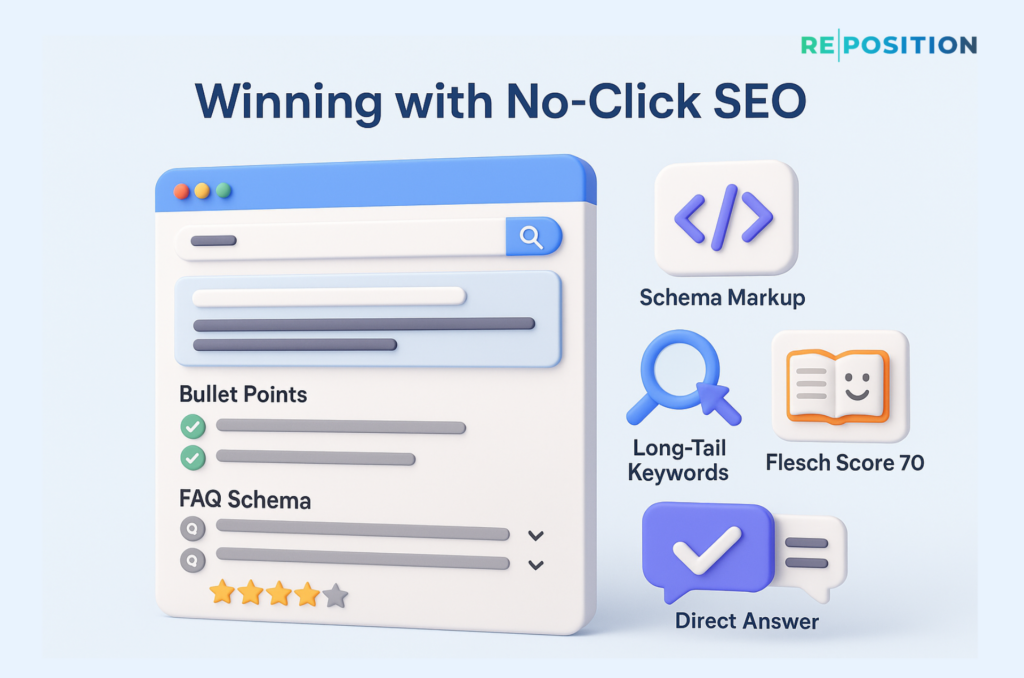No-Click SEO has emerged as a major shift that’s catching marketers and SEO professionals off guard. Once upon a digital time, being in the top spot on Google was like owning prime real estate. But now? Users are increasingly getting the answers they need without ever clicking a single link.
Let’s dig into what this means for your strategy, and whether traditional SEO goals like being “ranked #1” still carry the weight they once did.
What Is No-Click SEO?
No-Click SEO refers to search engine optimization strategies that account for search results where users get the answer directly from the search results page, without clicking through to a website. These often appear as:
- Featured Snippets (Position Zero)
- Knowledge Panels
- People Also Ask boxes
- Instant Answers (like weather, currency conversions, etc.)
Essentially, Google has become the endpoint, not the middleman.
How No-Click SEO Impacts Traditional Ranking Goals?
Getting that coveted #1 spot on Google was once the ultimate badge of honor. Today, it’s more complicated. If your site is ranking below a Featured Snippet, or your content is scraped to serve a direct answer, users may never actually visit your site.
And yet, your information is still being used to educate or guide them. That can hurt traffic, skew bounce rates, and even throw off analytics if you’re not tracking impressions in Google Search Console closely.
But here’s the twist: it’s not all bad news.
No-Click SEO Doesn’t Mean Zero Value
Contrary to what the term might imply, No-Click SEO can still build brand awareness, authority, and trust, especially if you’re the source of the zero-click result.
For instance, if your answer appears in a featured snippet, users still see your brand, even if they don’t click. That kind of visibility, especially on mobile, can drive brand recognition and top-of-mind recall down the line.
Think of it like this: the user didn’t click now, but they might search again later with higher intent.
Featured Snippets and EEAT: The Hidden SEO Opportunity
If you’re serious about dominating No-Click SEO, focusing on Google’s EEAT principles (Experience, Expertise, Authoritativeness, Trustworthiness) is essential. Google wants to highlight credible answers. That means content backed by real expertise, clear structure, and trustworthy data stands a better chance of landing in Position Zero.
Use structured data, proper headers (H1, H2, H3), and simple, concise answers. Keep sentences short, limit passive voice, and boost your readability score, just as Yoast recommends.
How to Optimize for No-Click SEO?

Here’s how you can win in this new environment:
- Structure your content for quick answers: Use bullet points, tables, and summaries.
- Answer questions directly: Use subheadings that mimic search queries.
- Use schema markup: Especially for FAQs, how-tos, and reviews.
- Improve readability: Aim for a Flesch Reading Ease score of 60–70.
- Target long-tail keywords: These are less likely to trigger instant answers and more likely to result in clicks.
When No-Click Is a Problem, And When It Isn’t
Not all content types are affected equally. Informational searches (“What is Bitcoin?”) are more likely to yield no-click results than commercial searches (“Best Bitcoin wallet for beginners”).
In other words, intent matters. If your content targets users at the “awareness” stage of the funnel, you might see fewer clicks. But if you’re targeting transactional intent (“Buy running shoes in Dubai”), users will still need to click.
So, Is Ranking #1 on Google Still Worth It?
Yes, but only if you redefine what “ranking” means.
The real goal isn’t always a click. Sometimes it’s visibility. Sometimes it’s trust. Sometimes it’s simply to be the first name users associate with a topic.
In many cases, ranking in a featured snippet is more impactful than holding the #1 blue link. It drives brand credibility and answers user intent quickly.
So, while the metrics of SEO success may evolve, the core value, being the trusted authority on a topic, remains constant.
No-Click SEO Is Not A Threat
No-Click SEO isn’t a threat, it’s an evolution. It’s a sign that Google is getting better at delivering answers and that your content needs to work harder (and smarter) to earn visibility.
Rather than chasing vanity metrics like “top position,” focus on:
- Owning the conversation through thought leadership
- Answering user queries more effectively
- Optimizing every snippet, schema, and sentence for maximum impact
Yes, the game has changed. But if you embrace it, you can still win.
FAQs
What’s the difference between No-Click SEO and Zero-Click Searches?
They’re often used interchangeably. However, No-Click SEO refers to optimizing your site for visibility despite no clicks, while Zero-Click searches describe the user behavior.
Can I still drive traffic with No-Click SEO?
Yes, especially if you position your site as a credible source through structured content, FAQs, and schema.
Should I avoid topics likely to trigger no-click results?
Not necessarily. They can still build brand awareness and support your funnel.
How can I measure success with No-Click SEO?
Use Google Search Console to track impressions, SERP features, and position even if clicks are low.
Are featured snippets good or bad for my site?
They’re often good, they boost visibility and can position your brand as a leader, even without a click.
Do voice searches relate to No-Click SEO?
Absolutely. Many voice assistants use featured snippets or Knowledge Graphs, both prime No-Click SEO real estate.

 SEO Services
SEO Services  Request a Quote
Request a Quote
 London
London
